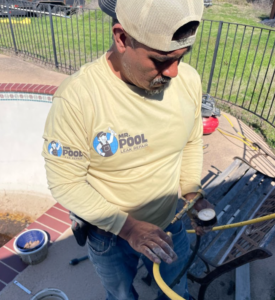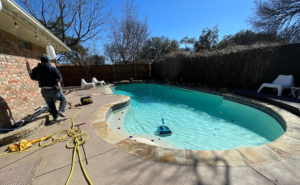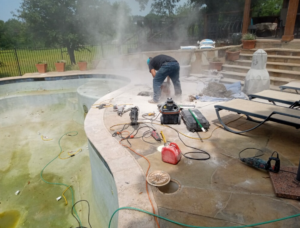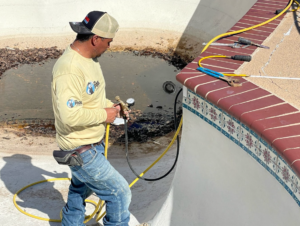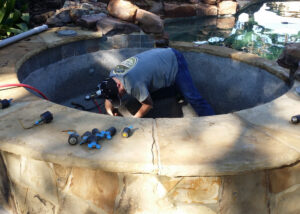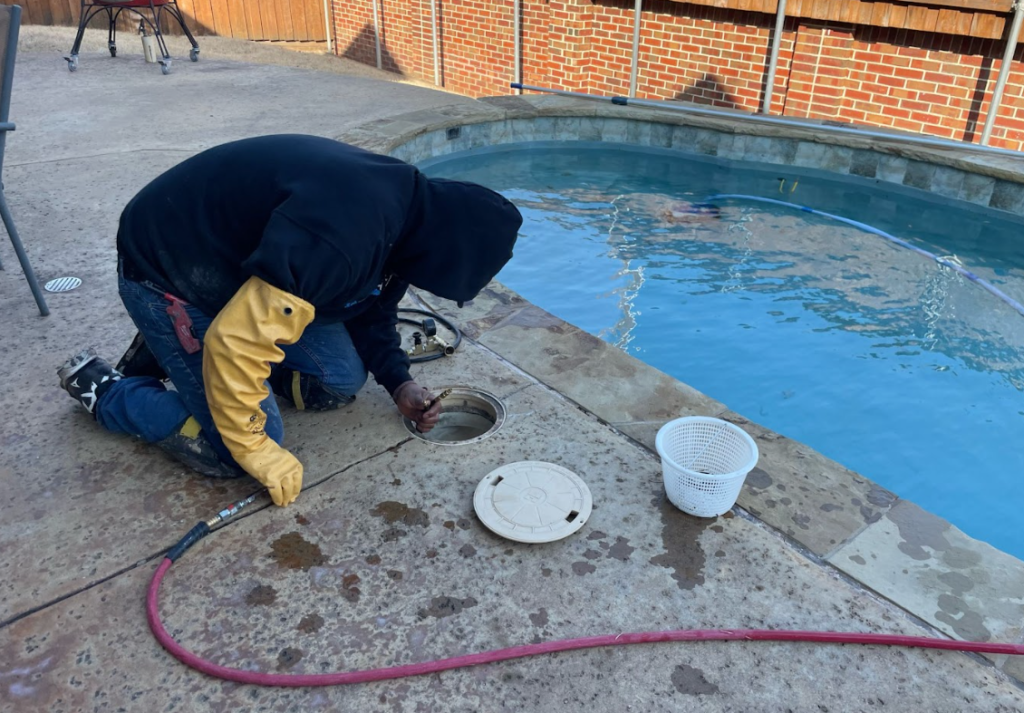
Leaks in the pool can be annoying, especially if you don’t understand where they are coming from. It is not uncommon for swimming pools to get damaged from time to time. However, this does not make the process of fixing a pool leak any easier.
This article will teach you everything about fixing a pool leak. Learn the essential steps and techniques for fixing a pool leak and get your pool back in top shape. Whether it’s identifying the source of the leak or employing the right tools and materials for repair, we’ve got you covered.
Contact Us
Natural water loss occurs in swimming pools due to splashing or evaporation. You may find that the water level in your pool is dropping more than an inch per week. You may have a small leak, and it’s worth investing some money to fix.
Leaks in pools can occur through plumbing, shells, fittings, accessories or other parts. To save on water, heat and chemicals, it is vital to be aware of pool leaks. By controlling pool leaks, you can prevent future structural damage to your swimming pool.
Repairing pool leaks is easy. If you are unable to fix the leak yourself, you may hire a Texas pool professional who is well-equipped to do so.
Evaporation of pool water
A pool professional with experience knows that water loss in the pool is not always due to hidden structural damage. Some pool water loss can be a simple result of evaporation. However, when it comes to fixing a pool leak, it is important to first determine if a leak is indeed the issue.
A surprising amount of pool leakage can be mistaken as water loss due to evaporation, which is caused by excessive heat. This is a common misconception, especially if you are a new owner of a swimming pool and not familiar with the normal evaporation rate for your pool.
The amount of water that your pool loses due to evaporation will vary depending on several factors. Location, ambient temperature, and water temperature are some of these factors. Without using a cover, you may lose more water, potentially misleading you into thinking it’s a case for fixing a pool leak.
Determine Your Pool Has a Leak
In Texas, for example, you can expect to lose between 1/16 and 1/4 inch of water per day due to evaporation. Other areas may have lower or higher rates. To determine whether your pool has a leak or is simply losing water due to evaporation, you can use a bucket test.
Conducting a bucket test is an essential first step in the process of fixing a pool leak. This is because it eliminates the external factors that affect your pool’s evaporation rate. By comparing the rate at which your pool is losing water to its rate of evaporation, you can more accurately determine if a leak is present.
If you suspect a leak, the bucket test should be your first action. Should the results be inconclusive, identifying the temperature changes from day to day can help you interpret your results more accurately, guiding you on whether fixing a pool leak is necessary.
How to Perform The Bucket Test
Fill a bucket of water with the same temperature as the water in your pool. Leave the water 2″ below the top. The bucket should be filled with enough water to make it heavy enough that it won’t float in the pool water.
Mark the level of water in the bucket with a piece masking tape.
Use another piece of tape to mark the level of water in the pool.
Check the water level in the bucket after 24 hours compared to the tape placed the day before.
Compare the level of the water in the pool with the tape placed on the tile at the waterline the day before.
You can assume that if you use a solar blanket to cover your pool at night, the pool’s water level will drop dramatically due to evaporation. You can expect to see your pool’s water level drop dramatically if you cover it with a solar sheet at night.
Note:
It is important to note the weather conditions during the time you are conducting the bucket test. This includes the temperature outside during the day, and at night. Also note the amount of cloud cover and wind. It is important to also note whether or not it has rained, since rain can invalidate the bucket test.
Swimming Pool Leak Detection
Leak detection is a highly specialized branch of the pool industry. Pool builders can make it easy to build a pool in Texas. Maintaining it can be a challenging task for you as a homeowner. It is no surprise that pool leak detection is a popular topic when it comes to swimming pools.
Leaks in your pool can cause you headaches. This could lead to an increase in water bills, chemical use, or even structural damage. It takes time to find and repair pool leaks. It is difficult to locate pool leaks.
The purpose of swimming pools is to keep them dry. Sealants can deteriorate over time, while other parts wear out or shift. You should be aware of the subtle signs that indicate a leak in your pool. You may miss something that an experienced eye would see. If you suspect that your pool has a leak, you can benefit from checking these things.
Contact Us
Does Your Pool Lose Water Only When The Equipment Is Turned On?
It could be a leak on the pressure side. The plumbing on the pool’s pressure side is under pressure when the filter pump is running. The pressure can cause small drips of water to become gushing spouts.
You can fix this by checking your pool’s waste or backwash lines to see if there is water flowing. Look for weepers near the area where a leak may be visible. You can also check for soft or moist areas in your yard, or on the side or your swimming pool where the plumbing system returns the water.
Does Your Pool Lose Water Only When You Turn Off The Equipment?
If you answered yes, the leak may be suction side, meaning that it is located on the pipes that are bringing water into your pool. The plumbing on the suction side of the pool is vacuumed when the filter pump is running, so air is drawn into any voids. If there’s air in the basket of the pump, bubbles coming out of the return line, or air building up inside the filter, you know that it is a suction side leak.
Does Your Pool Leak Constantly?
It’s not necessary that your plumbing is the cause of the constant leakage in your pool. You can keep an eye out for any cracks or dents in your plaster. Inspect the tile line, and the interior of your skimmers. Leaks are often caused by the separation of the plastic skimmer from the concrete pool.
You can use pool putty or test dye to repair any cracks you see in the area. The pump should be turned off. Leaks can also be detected by underwater lights, particularly the conduit running from the junction box to the light niche.
Are You Noticing Leaks On The Equipment Pad?
It is also helpful to examine the heater, filter, pump and valves when identifying possible leaks. If you turn off the pump, check if water sprays out. If there is a noticeable loss of water in the pool then a small drip may not be the cause.
Does The Water Level Out At A Certain Level?
Close the skimmer and allow the water to drop below the skimmer, while running the main drain pump. You can rule out the skimmer if you see that the water level continues to drop.
If the water level stabilizes, you should conduct a dye-test and inspect your pool carefully. There could be debris in the crack. This is a sure sign of a leak. If the water is stopping at a wall fixture, pool light or wall step there may be a void. You can plug in the drain, return, and skimmer lines with expansion plugs to eliminate the possibility of plumbing.
Are There Any Wet Spots Around The Pool Area?
You can also detect leaks by walking outside the deck of the pool, and between it and the equipment. You can also walk downhill to see if water is dripping from the slope.
Any part of your equipment or pool that is damaged or worn out should be considered suspect in detecting leaks. If there is a pool leak, it’s likely to cause damage around the pool. Most of the time these damages will be visible.
Leaks can be detected by pool decks that are sinking or cracked. If you are looking for the source of your pool’s water loss, then look out for any holes in your liner, patches, rust around your skimmer or cracks on your pool floor.
When pool owners call Mr Pool Leak to inspect their pool, our pool professionals will look for this first. If you’ve noticed any damage to your pool or suspect that there may be a leak in an area of your pool or surrounding it, you should perform a dye test.
Leaks in a pool can be caused by a variety of factors. There are many reasons why a leak in the pool’s plumbing can occur. See how our pool inspectors, who are highly trained and experienced, use cutting-edge technology in order to find the source of leaks.
Swimming Pool Dye Test
You can use dye to test a specific area in your pool where you suspect a leak. This test involves releasing a small amount of dye at the location you suspect is leaking.
If you are going to conduct a dye test in your swimming pool, ensure that the circulation system has been turned off. Also, there should be no wind or very little movement of your water. You should also be as calm and still as you can when performing this test. Even putting your hand in the water will cause the water to move, making it difficult to determine the results.
Release a steady flow of dye in the area around the suspected leak. The dye will tend to float and stay together with the slight motion of the moving water once you have released it. You will be able to see the dye actively being pulled out of the water through the leak if there is one.
The dye test is especially useful for testing around lights, steps, and skimmers.
The key to detecting a leak with this test is to watch the dye move in the water. Note that dye tests are not recommended for cracks on the pool floor or the main drain unless you can get close to the area with scuba gear.
While dye leak detection is not always definitive, it can be a useful tool to use if you are looking to find leaks in your pool. Ordering syringes for leak testing is a good idea, but don’t buy too many as you won’t use them all up quickly.
Remember that dye is not always enough to detect a leak. You may not be able to pinpoint the leak with this test.
The dye tester is only used as an additional tool in the leak detection process. Don’t expect it to be a magical beacon that points out your pool leak. Find the ultimate pool leak detector in Bradenton.
Pool Leak Repair
Don’t worry if you find out that your pool actually leaks. There are a few ways to fix a pool quickly and easily. We can fix your pool and get it ready to swim again.

